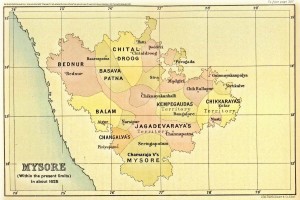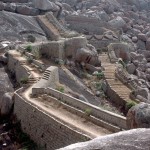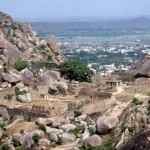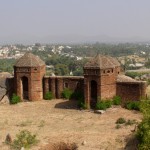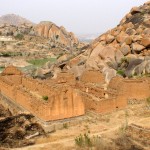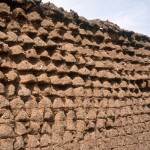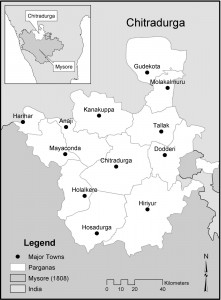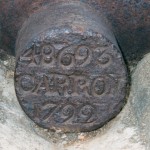
Much of Karnataka endured chronic social and political upheaval in the centuries between the collapse of the Vijayanagara Empire in the late 1500s and the death of Tipu Sultan in 1799. It was an era of dynamic change, during which petty rulers and chiefs, variously called “little kings,” nayakas, and poligars in historical accounts, fought war after war against outsiders and each other. Mysore was ultimately the most successful of these polities and its history dominates what has been written about this period. Several smaller kingdoms, most notably Chitradurga and Keladi (Bednur, Bednore), endured into the middle 1700s and were of considerable regional importance.
Between 1500-1800, Chitradurga was at times a province of Vijayanagara, an independent kingdom, a tributary of the Marathas, a tributary of the Mughals, a tributary of Mysore, and finally, a Mysore province. In spite of this tumultuous past, the Chitradurga nayakas have received so little attention from modern researchers that, until recently, its story was only a modest footnote in Karnataka history.
Origins of the Chitradurga Nayakas
Chitradurga was one of several central Karnataka regions governed by local chieftains well before the rise of Vijayanagara, which inherited control of the region from the Hoysalas in the 1300s. By the 1500s, it was largely dominated by Bedar (Valmiki) families who traced their origins to southern Andhra Pradesh from which they had emigrated with their herds. Like most of the families that rose to power in the 1500s, the Chitradurga nayakas based the legitimacy of their rule on their relationship with the Vijayanagara kings, who appointed several of their line as local governors after they attracted the attention of the Vijayanagara rulers through acts of daring and bravery.
One such ruler was Timmanna Nayaka, who was attacked by a Vijayanagara force in the early 1560s because he had raided neighboring poligar territories. In a daring act of bravery and sheer arrogance, Timmanna Nayaka decided to steal the horse of the Vijayanagara prince who commanded the forces sent against him. Under cover of night, he stole into the enemy camp and found the prince’s horse. Before he could make his getaway, a groom arrived to re-tether the horse. Hiding literally at the groom’s feet, Timmanna Nayaka lay unnoticed in the darkness as the groom drove the tether rope peg through his hand. Pinned to the ground, Timmanna Nayaka waited for the groom to leave, cut off his hand to free himself, and rode away on the prince’s horse. It is said that the event convinced the Vijayanagara army that they could not defeat Timmanna Nayaka and they sued for peace. The Vijayanagara king formally appointed him as the governor of Chitradurga and he enjoyed a brief interlude of favor at court. Regrettably, it did not last and he died in prison at Vijayanagara.
Chitradurga Fort is the most visible modern reminder of the nayakas who once held sway across this part of central Karnataka. Although traces of older fortification walls can still be found there (the best example being the early Vijayanagara era covered gateway and walls you pass through when you enter the fort past the ASI ticket booth on TaRaSu Street), most of the standing walls and gateways were constructed by the Chitradurga nayakas and Tipu Sultan. This fort was effectively the heart of the kingdom.
Independence and Expansion
After the fall of the city of Vijayanagara in 1565, the Chitradurga family and most other central Karnataka nayakas soon declared their independence of the remnants of that empire. They also were in the thick of the chronic regional warfare that devastated central Karnataka for the next 250 years. They warred repeatedly with the Basavapatna or Tarikere poligars whose country lay to the west, with the Harapanahalli poligars to the north at Uchchangidurga; with the Harati or Nidugal family at Dodderi and later at Nidugal; with the Hatti family, whose headquarters town was Nayakanahatti; and with the Rayadurga poligars, among others. The political stability of the region was complicated further in the mid-1600s, when the Mughals invaded central Karnataka and established the suba or major province of Sira. Although the territories of many former poligars in the region became parganas or lesser provinces under the Mughals, Chitradurga was one of the fortunate few to enjoy limited independence as a tributary of Sira.
These events did not lessen the pace of regional warfare, which continued on the borders of Chitradurga. The story of the unfortunate end of Bharamappa Nayaka’s son, Hire Madakeri Nayaka, illustrates the temper of this era. He succeeded to the Chitradurga throne in 1721 and the kingdom enjoyed considerable military and economic successes during his reign. It ended, however, when a coalition of armies of the principal poligars whose territories bordered that of Chitradurga drew him into a decisive battle at Mayaconda around 1747. A kafiyat or town history, which was recorded at Mayaconda in 1801, describes how Hire Madakeri Nayaka advanced to receive the attack of his enemies with 20,000 Chitradurga soldiers and 5,000 soldiers of his Maratha allies. When the armies met, however, the Marathas refused to fight, having reputedly been bribed by the poligar coalition to stay out of the battle. Rather than retreat, Hire Madakeri Nayaka advanced to meet the enemy on his war elephant and engaged Konati Nayak, the Rayadurga poligar (other sources say it was Somashekhara Nayaka of Harapanahalli) in personal combat, chaining their elephants’ legs to hold them steady. Wounded by Konati Nayak’s arrows, Hire Madakeri Nayaka fell from his elephant and was beheaded by soldiers of the Savanur poligar. Defeated, the Chitradurga troops retreated and the poligar coalition army laid siege to Mayakonda fort for several months. The siege was eventually lifted by Hire Madakeri Nayaka’s son, Kasturi Rangappa Nayaka II.
Today, little evidence marks the mid-1700s clash of armies at Mayakonda. There also is no trace of the substantial fort that once stood here. All that remains is a small mantapa a little beyond the north side of town. Largely obscured by the grass and weeds around it, one can see the faint outline of what was once a small ornamental garden in the Mughal style. Here is where Hire Madakeri Nayaka’s body was burned, closing the chapter on one ruler’s reign and beginning a fresh and equally violent one for his successor.
The Fall of the Chitradurga Nayakas
Chitradurga’s political position became untenable in the mid-1700s after it was caught between the Marathas and Haidar Ali of Mysore in their struggle for control of central Karnataka. Gambling that the Marathas would eventually prevail, the Chitradurga rulers entered into secret negotiations with them. Had the plan succeeded, they would have had a valuable ally in their continuing military conflicts with the Keladi (Bednore) kings of modern-day Shimoga district; it may have even helped them to sustain their rule into the 19th century.
Haidar Ali, however, proved to be more than equal to the task of dealing with Chitradurga and thwarting the regional ambitions of the Marathas. After three sharp clashes with Chitradurga in the 1760s and 1770s, Haidar Ali finally took the fort in 1779 and the region became a Mysore province. Madakari Nayaka IV, the last ruler of Chitradurga, and his family were imprisoned at Shrirangapattana, where they died. To break the power of the Bedar caste in the region, which had loyally supported the Chitradurga nayakas, Haidar Ali is said to have moved more than 20,000 Bedars from Chitradurga to Shrirangapatana, the young men of which were pressed in his chela battalions and recruited into his army. As Mark Wilks, the historian and early British Resident at Mysore, noted in the early 1800s, Chitradurga soldiers in the Mysore army enjoyed a reputation for bravery and military effectiveness in the Mysore wars that followed in the late 1700s.
Among the many heroes and heroines of Chitradurga, mention must be made of Onake Obavva, the wife of a common soldier, who, while fetching water during one of the several sieges of the fort, heard the muffled sound of enemy soldiers attempting to enter the fort walls through a small crevice that was just big enough for one person at a time to crawl through. Hiding silently next to the crevice with an onake, or pestle, she killed each soldier as his head appeared in the opening and dragged his body inside the wall. By the time her husband and others came to her aid, many dead soldiers lay around her. Onake Obavva’s courage and quick thinking single-handedly saved the fort that day. Her bravery is commemorated in Chitradurga by the name of Onake Obavva Stadium and by an extraordinary new sculpture near the DC Office. The sculpture was commissioned by the Government of Karnataka and brilliantly executed by the distinguished sculptor Ashok Gudigar.
Chitradurga in the Early 1800s
After Tipu Sultan’s death in early May of 1799, which marked the end of the 4th Mysore War, the Mysore kingdom was recreated under the Wodeyars. Chitradurga remained a Mysore province and was governed from Mysore. Chitradurga Fort, which was viewed by the British as a potentially useful base along Mysore’s northern line of defense, was garrisoned by British troops between 1799-1809, after which it passed back into the hands of the Mysore government.
As an epilogue to the story of the Chitradurga nayakas, British troops detained Dodda Madakari Nayaka, a cousin of Madakari Nayaka IV, at Calicut in Malabar in early 1800. He requested a troop escort and passports so he could visit Madras to make his claim as the legitimate successor to Madakari Nayaka IV. After what was undoubtedly very careful consideration of the political implications of his requests, the Governor-in-Council at Madras rejected his claim to Chitradurga because Madakari Nayaka IV surrendered to Haidar Ali before the British conquest of Mysore and Dodda Madakari Nayaka had entered the service of Haidar Ali after the fall of Chitradurga, but later deserted to Travancore. By this reasoning, he had no legitimate claim to the territory of Chitradurga, whether from his relationship with Madakari Nayaka IV or with Tipu Sultan. It should also go without saying that, had the Governor-in-Council approved Dodda Madakari Nayaka’s requests, it could ultimately have posed a threat to the stability of the Wodeyar government in Mysore. Such a possibility, of course, was not in the interests of the Wodeyars or the British. According to G. N. Saletore’s account of these events Dodda Madakari Nayaka was eventually granted a pension by Dewan Purnaiya, regent for Mummadi Krishnaraja III Wodeyar of Mysore.
Until the late 1990s when Davangere district was created, the boundaries of Chitradurga district reflected its nayaka heritage. Its boundaries encompassed most of the territory held by Madakeri Nayaka IV when Chitradurga Fort fell to Haidar Ali.
Acknowledgements
This is a slightly revised and updated version of an article that appeared in Jaya-Vijaya: A Commemorative Volume (2006), pp. 140-150. Houston, TX: Kannada Vrinda. I called it an “informal history” because I compiled it fairly uncritically from secondary sources available in English. I took the liberty of placing the article on the web because Chitradurga deserves to be far better known than is currently the case. A proper history of Chitradurga has yet to be written.
Sources
Patil, C. S. (1999) Karnataka Kotegalu [Forts of Karnataka]. Hampi: Kannada University.
Puttanna, M. S. (1924) Chitradurgada Paleyagararu [Chitradurga Poligars]. Bangalore.
Ramachandra Rao, P. B. (1943) The Poligars of Mysore and Their Civilization. Teppakulam: Palaniappa Bros.
Rice, B. Lewis (1897) Mysore: A Gazetteer Compiled for Government. Revised edition. 2 Vols. London: Archibald Constable and Company.
Rice, B. Lewis (1903) Inscriptions in the Chitaldroog District. Epigraphia Carnatica, Vol. XI. Bangalore: Mysore Government Central Press.
Saletore, R. N. (1940) The Conquest of Citradurga by Hyder Ali. Quarterly Journal of the Mythic Society 29:171-188.
Sathyan, B. N., ed. (1967) Mysore State Gazetteer: Chitradurga District. Bangalore: Government Press.
Srikanta Sastri, S. (1928) Capitulation of Chitradurga. Quarterly Journal of the Mythic Society 18:145-154.
Srikantaya, S. (1941) Chitaldrug. Quarterly Journal of the Mythic Society 31:339-356.
Wilks, Mark (1989) Historical Sketches of the South of India in an Attempt to Trace the History of Mysore. 2 vols. Reprint of 1930 edition; originally published in 1810. New Delhi: Asian Educational Services.


